
Как стать брокером в 2026 году?
В статье
Чтобы начать торговать в качестве брокера, вам необходимо зарегистрировать юридическое лицо, получить лицензии, определить рыночную нишу, установить свою торговую инфраструктуру и привлечь клиентов через маркетинг. Это структурированный процесс, включающий в себя планирование, соблюдение требований, развертывание технологий и постоянные инновации.
Вот пошаговое руководство, которое охватывает все, начиная от выбора ниши и юридического соответствия до создания вашей платформы, открытия бизнеса и успешного расширения вашего брокерского дела.
Чек-лист требований к брокерам (Быстрый старт)
- Выберите свою нишу и аудиторию (Форекс, акции, криптовалюта, товары; профили трейдеров)
- Выберите юрисдикцию (сроки, капитал, налоги и соответствие регуляторам)
- Форма компании (юридическое лицо, корпоративные документы, директора, долевое участие)
- Лицензионный и комплаенс-план (заявка на лицензию, назначение комплаенс-офицера, подготовка AML/KYC, политики по рискам и отчетности)
- Капитал и финансы (минимальные требования к капиталу, открытие банковского счета, настройка платежей/ПСП)
- Технологический стек (торговая платформа, мост ликвидности, данные потоков, хостинг)
- Бэк-офис и CRM (KYC/ONB, клиентский портал, тикетинг, выставление счетов, аналитика)
- Безопасность & защита данных (контроль кибербезопасности, резервное копирование, GDPR/PDPA)
- Ликвидность & исполнение (соглашения с поставщиками ликвидности, маршрутизация, проскальзывание & параметры риска)
- Бизнес-план и модель (P&L, срок финансирования, цены/спреды, условия IB/партнёрства)
- Веб-сайт & юридические документы (Условия, Раскрытие рисков, Конфиденциальность, Файлы cookie, Проверка PEP/санкций)
- Выход на рынок (SEO/контент, платное привлечение, партнерство, сеть IB)
- Обучение клиентов и поддержка (база знаний, вебинары, многоязычные соглашения об уровне обслуживания)
- Тестирование перед запуском (UAT, песочница, нагрузки и & тесты безопасности, сценарии инцидентов)
- Текущие обязательства (регуляторная отчетность, аудиты, сверка, итерация дорожной карты)
Шаги к тому, чтобы стать брокером
- Определите свою нишу брокера
- Юридическая регистрация и соблюдение нормативных требований
- Разработать бизнес-план
- Настроить операционную инфраструктуру
- Реализовать стратегии маркетинга и привлечения клиентов
- Принятие инноваций и технологических достижений
Теперь, когда мы изложили основные шаги для того, чтобы стать брокером, давайте углубимся в каждый из них, чтобы понять детализированные процессы и лучшие практики, связанные с успешным запуском и управлением брокерской фирмой.
Шаг 1: Определите свою нишу брокера
Одно из самых важных решений на начальных этапах создания брокера - это выбор правильной ниши. Этот выбор значительно повлияет на вашу бизнес-модель, клиентуру, которую вы привлечете, и на то, как вы будете ориентироваться в регулирующей среде. Ниша, которую вы выбираете - будь то акции, Форекс, недвижимость, товары или другие - задает тон всей вашей деятельности.
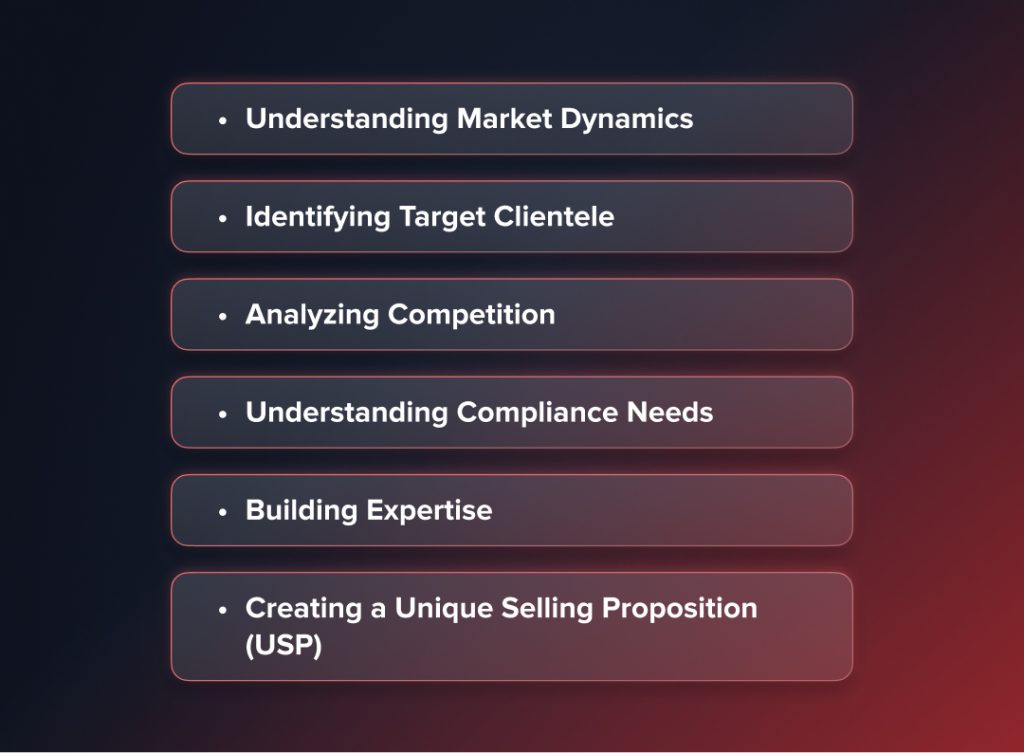
Понимание рыночной динамики
Прежде чем определиться с нишей, исследуйте текущую динамику, тренды и будущие прогнозы потенциальных рынков. Это включает в себя анализ объема рынка, потенциала роста и волатильности, что имеет решающее значение для определения устойчивости и прибыльности ниши.
Определение целевой аудитории
Каждая ниша привлекает разный тип клиентов. Например, рынки Форекс могут заинтересовать клиентов, заинтересованных в быстром темпе торговли, в то время как недвижимость может привлечь тех, кто ищет долгосрочные инвестиции. Понимание потребностей, поведения и предпочтений вашей целевой аудитории имеет решающее значение для эффективной настройки ваших услуг.
Анализ конкуренции
Изучите существующую конкуренцию в выбранной вами нише. Определите основных игроков, их предложения, сильные и слабые стороны. Эта информация поможет вам отличить ваши услуги и найти ниши на рынке, которые ваша брокерская компания может занять.
Понимание потребностей в соблюдении
Разные ниши имеют различные регуляторные требования. Например, брокеры по акциям должны соблюдать другие правила, чем брокеры по Forex или недвижимости. Ознакомьтесь с этими требованиями на раннем этапе, чтобы обеспечить соответствие и избежать юридических проблем.
Вам также может понравиться

Формирование экспертизы
В зависимости от ниши, вам могут потребоваться специфические знания или сертификаты. Например, агентству недвижимости будет полезен опыт в области имущественного права и местных рынков недвижимости, в то время как брокерская компания по акциям может требовать глубоких знаний об акционерных рынках и торговых технологиях.
Создание уникального торгового предложения (УТП)
Как только вы поймете свою нишу, подумайте о том, какую уникальную ценность ваше брокерское агентство может предложить. Это может быть инновационная технология, превосходное обслуживание клиентов, экспертиза в нишевом рынке или конкурентные цены. Ваше УТП (уникальное торговое предложение) то, что выделит вас среди конкурентов и привлечет клиентов в ваше брокерское агентство.
Итог
Определение ниши вашего брокера заключается не только в выборе сегмента рынка; это также связано с согласованием вашего бизнес-видения с рыночными возможностями и потребностями клиентов. Хорошо выбранная ниша, основанная на тщательном исследовании и четком понимании нормативных требований, закладывает прочный фундамент для вашей брокерской фирмы.
Модели брокерского бизнеса: какая из них подходит вам?
Прежде чем разрабатывать платформу или подавать заявку на лицензию, вам необходимо определить, как будет работать ваше брокерское дело. Ваша бизнес-модель влияет на все, от регулирования и технического стека до доходов и пользовательского опыта.
Общие модели брокерских услуг
1. Дилерский стол (Маркет Мейкер)
- Вы выступаете в качестве контрагента для сделок клиентов, предоставляя внутренние цены покупки и продажи.
- Плюсы: Больший потенциал дохода за счет спредов и ордерного потока.
- Минусы: Требует строгого управления ликвидностью и является более рискованным.
- Лучше всего для: Хорошо капитализированные брокерские компании, которые нацелены на розничных клиентов с узкими спредами.
2. STP (Прямой процессинг)
- Заказы отправляются напрямую внешним поставщикам ликвидности без вмешательства дилерского стола.
- Плюсы: Меньше рисков и меньше конфликта интересов.
- Недостатки: Прибыльные маржи уже, так как доход в основном основан на спредах или комиссиях.
- Лучше всего для: стартапов или средних брокеров, которые придают приоритет прозрачности и низкорисковым операциям.
3. ECN (Электронная Сетевая Связь)
- Заказы клиентов сопоставляются с другими участниками рынка в условиях объединенной ликвидности.
- Плюсы: Чрезвычайно прозрачное ценообразование, более узкие спреды и отсутствие риска со стороны дилеров.
- Недостатки: Сложные требования к технологиям, более высокие начальные затраты и большее регулирование.
- Лучше всего для: Брокеров институционального уровня или брокеров, ориентирующихся на профессиональных трейдеров.
4. Брокерская компания под собственным брендом
- Вы заключаете соглашение с поставщиком технологий, который предоставляет торговую платформу, а также инфраструктуру.
- Плюсы: Быстрое время выхода на рынок, значительно более низкие стартовые затраты и бесшовная масштабируемость.
- Недостатки: Меньше контроля над технологиями и потенциальные ограничения по кастомизации.
- Лучше всего для: Новых основателей брокерских компаний или тех, кто тестирует новые рынки.
Выбор правильной модели с самого начала позволяет вам выровнять вашу лицензионную стратегию, технологический стек, настройку ликвидности и маркетинговую стратегию с первого дня.
Шаг 2: Юридическая регистрация и соблюдение норм
Следующий шаг включает в себя юридическую регистрацию бизнеса и обеспечение соответствия всем применимым законам и нормативным актам. Этот процесс варьируется в зависимости от местоположения и типа брокерской компании. Для создания надежной и законной деятельности важно понимать правовую основу, регулирующую финансовые брокерские компании в желаемом регионе, и строго соблюдать эти нормы.
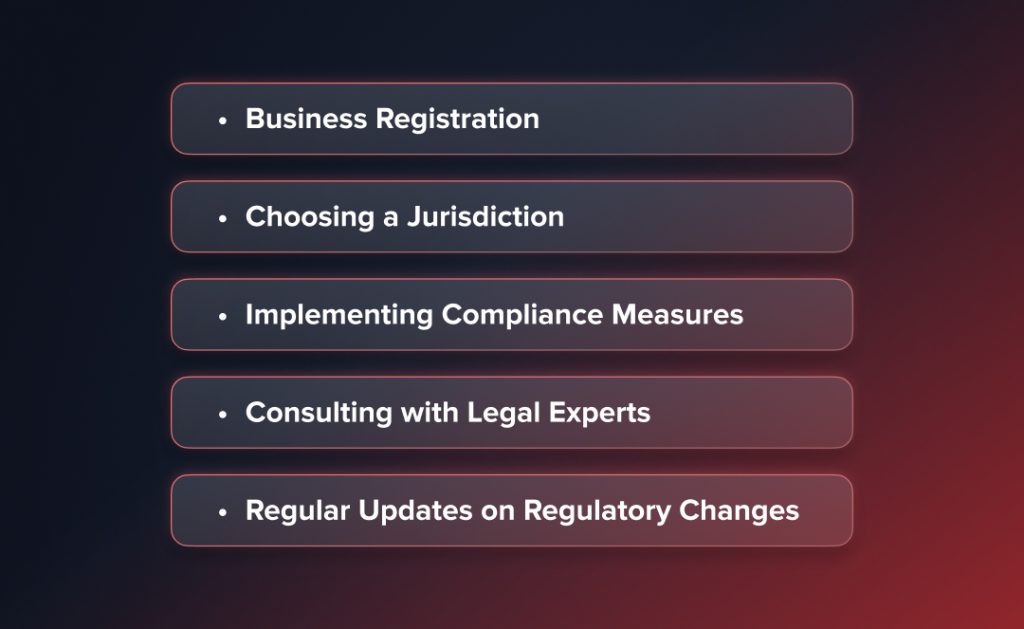
Регистрация бизнеса
Первый шаг — это зарегистрировать ваше брокерское предприятие как юридическое лицо. Это включает в себя выбор подходящей организационно-правовой формы (например, корпорация, партнерство или индивидуальное предприятие), что может повлиять на налогообложение, ответственность и соблюдение нормативных требований. Процесс регистрации обычно требует подачи определенных документов и информации о вашем брокерском предприятии в соответствующий государственный орган.
Выбор юрисдикции
Юридические требования к брокерским компаниям могут значительно различаться в зависимости от региона. Важно выбрать юрисдикцию, которая соответствует вашим бизнес-целям и уровню комфорта в отношении регулирования. Учитывайте такие факторы, как регулирующая среда, налоговые последствия и политическая и экономическая стабильность региона.
Реализация мер по соблюдению
Обеспечение постоянного соблюдения включает в себя установление внутренних политик и процедур, соответствующих нормативным стандартам. Это включает в себя меры по защите клиентов, финансовой отчетности, практикам противодействия отмыванию денег (AML) и другие процессы, связанные с соблюдением.
Консультации с юридическими экспертами
Учитывая сложность финансовых регуляций, настоятельно рекомендуется консультироваться с юридическими экспертами, специализирующимися на финансовых услугах. Они могут предоставить рекомендации по процессу регистрации, необходимым лицензиям и текущим требованиям соблюдения.
Регулярные обновления о нормативных изменениях
Финансовая регулирующая среда динамична, с частыми обновлениями и изменениями. Важно быть в курсе этих изменений и соответственно адаптировать свои стратегии соблюдения требований, чтобы поддерживать законный статус и защищать свой бизнес от потенциальных юридических проблем.
Итог
Юридическая регистрация и соблюдение норм — это не просто бюрократические шаги, а основополагающие элементы для создания и функционирования надежной и заслуживающей доверия брокерской фирмы.
Требования к лицензии брокера по регионам
Одним из самых важных ранних решений является выбор места для регистрации и лицензирования вашей брокерской компании. Каждая юрисдикция имеет разные требования к капиталу, нормативные ожидания и сроки одобрения, что влияет на ваши расходы, скорость выхода на рынок и долгосрочную стратегию.
| Юрисдикция | Основной регулятор | Минимальный капитал | Тип лицензии | Типичный срок |
| США | FINRA / SEC | $50,000+ | Лицензия брокера-дилера | 4-6 месяцев |
| Великобритания | FCA | £100,000+ | Лицензия инвестиционной компании FCA | 3-5 месяцев |
| Кипр (ЕС) | CySEC | €125,000+ | Лицензия CIF | 3-6 месяцев |
| ОАЭ | DFSA / FSRA | $250,000+ | Лицензия на финансовые услуги | 4-8 месяцев |
| Австралия | ASIC | AUD 50,000+ | Лицензия на финансовые услуги Австралии (AFSL) | 4-6 месяцев |
| Маврикий | FSC | $25,000+ | Лицензия инвестиционного дилера | 2-4 месяца |
| Сейшельские Острова | FSA | $50,000+ | Лицензия на ценные бумаги | 2-3 месяца |
Ваш выбор юрисдикции определяет всю вашу стратегию брокерской деятельности. Учитывайте местоположение клиента, маркетинговую стратегию, регуляторное бремя, налоговую среду и доверие инвесторов перед подачей заявки.
Шаг 3: Разработка бизнес-плана
Разработка бизнес-плана имеет решающее значение для заложения фундамента успешного брокериджа. Этот план не просто финансовая схема; это всеобъемлющая стратегия, охватывающая каждый аспект вашего бизнеса, направляющая его рост и обеспечивающая операционную стабильность.
Ключевые компоненты бизнес-плана брокерской компании
- Исполнительное резюме: Начните с четкого и краткого исполнительного резюме, которое описывает миссию, видение и основные цели вашего брокера. Этот раздел должен предоставить общее представление о вашей бизнес-стратегии и о том, чего вы стремитесь достичь в брокерской индустрии.
- Анализ рынка: Проведите тщательный анализ рынка, включая оценку потенциальных клиентов, конкурентов и общих рыночных трендов. Этот анализ должен дать представление о том, как ваша брокерская компания вписывается в рынок и как она может использовать неудовлетворенные потребности или возникающие тренды.
- Услуги и продукты: Подробно опишите ассортимент услуг и продуктов вашей брокерской компании. Это должно соответствовать выбранной вами нише и целевому рынку, будь то торговля акциями, торговля на Форекс, торговля товарами или другие финансовые инструменты.
- Операционный план: Опишите, как ваша брокерская компания будет функционировать на ежедневной основе. Это включает в себя ваше местоположение, технологии и платформы, которые вы будете использовать, потребности в персонале и любые другие операционные детали.
- Маркетинговая и продажная стратегия: Разработайте всеобъемлющую маркетинговую и продажную стратегию. Опишите, как вы будете привлекать и удерживать клиентов, включая ваш подход к брендингу, маркетинговые каналы и тактики продаж.
- Финансовые прогнозы: Финансовый прогноз является критически важным компонентом вашего бизнес-плана. Это должно включать стартовые затраты, прогнозируемую выручку, прогнозы прибыли и убытков, анализ денежного потока и анализ безубыточности. Будьте реалистичны в своих прогнозах и основывайте их на тщательном исследовании рынка и здравых финансовых принципах.
- Управление рисками: Определите потенциальные риски и проблемы, с которыми может столкнуться ваша брокерская компания, и как вы планируете их минимизировать. Это может включать рыночные риски, изменения в регулировании или операционные проблемы.

Обеспечение начального капитала
Определите сумму капитала, необходимую для начала работы вашего брокера и поддержания операций до тех пор, пока он не станет прибыльным. Изучите различные источники финансирования, включая личные сбережения, кредиты, финансирование от инвесторов или партнерства.
Вам также может понравиться

Управление финансами для роста
Важно иметь стратегию эффективного управления финансами вашего брокерского бизнеса. Это включает в себя разумное финансовое управление, бюджетирование и реинвестирование прибыли для поддержки устойчивого роста и операционной стабильности.
Финансовое соответствие
Убедитесь, что ваши практики финансового управления соответствуют нормативным требованиям, особенно в отношении клиентских средств, капитальных резервов и финансовой отчетности.
Итог
Хорошо продуманный бизнес-план является дорожной картой вашего брокерского дела к успеху. Он направляет ваши решения, помогает обеспечить финансирование и готовит вас к будущим вызовам и возможностям. Этот план должен быть динамичным, развиваясь по мере роста вашего брокерского дела и изменений на рынке, что обеспечивает вашей фирме стабильность и курс на долгосрочный успех в секторе финансовых услуг.
Сколько стоит открыть брокерскую компанию?
Один из первых вопросов, которые задают потенциальные брокеры: "Сколько денег нужно для старта?" Ответ зависит от вашей бизнес-модели, юрисдикции и уровня технологий, но вот общее представление о типичных стартовых расходах:
| Категория расходов | Ориентировочный диапазон |
| Регистрация компании и юридические расходы | $5,000 - $20,000 |
| Лицензирование и минимальный капитал | $50,000 - $250,000+ |
| Торговая платформа и технологическая инфраструктура | $20,000 - $100,000+ |
| Вебсайт, клиентский портал и CRM-системы | $5,000 - $30,000 |
| Маркетинг и привлечение клиентов | $10,000 - $50,000 |
| Зарплаты сотрудников и операционные расходы (первый год) | $50,000 - $200,000+ |
Если создание с нуля слишком дорого, рассмотрите решения по брокерству под белые бирки. Эти готовые платформы позволяют вам запуститься гораздо быстрее и обычно стоят всего $20,000, что значительно снижает ваши первоначальные инвестиции.
Хронология: Сколько времени нужно, чтобы открыть брокерскую компанию?
Создание брокерской компании не происходит за одну ночь: обычно это занимает от 6 до 12 месяцев от концепции до фактического запуска на рынке. Продолжительность может варьироваться в зависимости от выбранной юрисдикции, сложности лицензирования, а также настройки технологий.
Средний срок создания брокерской фирмы:
- Месяц 1-2: Провести исследование рынка, выбрать свою нишу и определить свою бизнес-модель.
- Месяц 2-4: Зарегистрируйте компанию, подготовьте документы по соблюдению норм и подайте заявку на получение лицензии.
- Месяц 4-6: Выберите и внедрите торговые платформы, постройте инфраструктуру, наймите ключевых членов команды и настройте внутренние процессы.
- Месяц 6-8: Разработайте и протестируйте свои маркетинговые кампании, создайте свой веб-сайт и проведите мягкий запуск или бета-фазу.
- Месяц 8-12: Официально запустите ваше брокерское дело, привлекайте клиентов и масштабируйте усилия по привлечению.
Важно: На высокорегулируемых рынках, таких как США, ОАЭ или Великобритания, получение лицензии может延长 сроки до более чем 12 месяцев, поэтому планируйте свою стратегию запуска соответственно.
Шаг 4: Настройка операционной инфраструктуры
Настройка операционной инфраструктуры является ключевым шагом в запуске вашего брокерского бизнеса. Этот этап включает в себя создание физической и технологической основы вашего бизнеса, обеспечивая эффективные операции и предоставление услуг высокого качества клиентам.
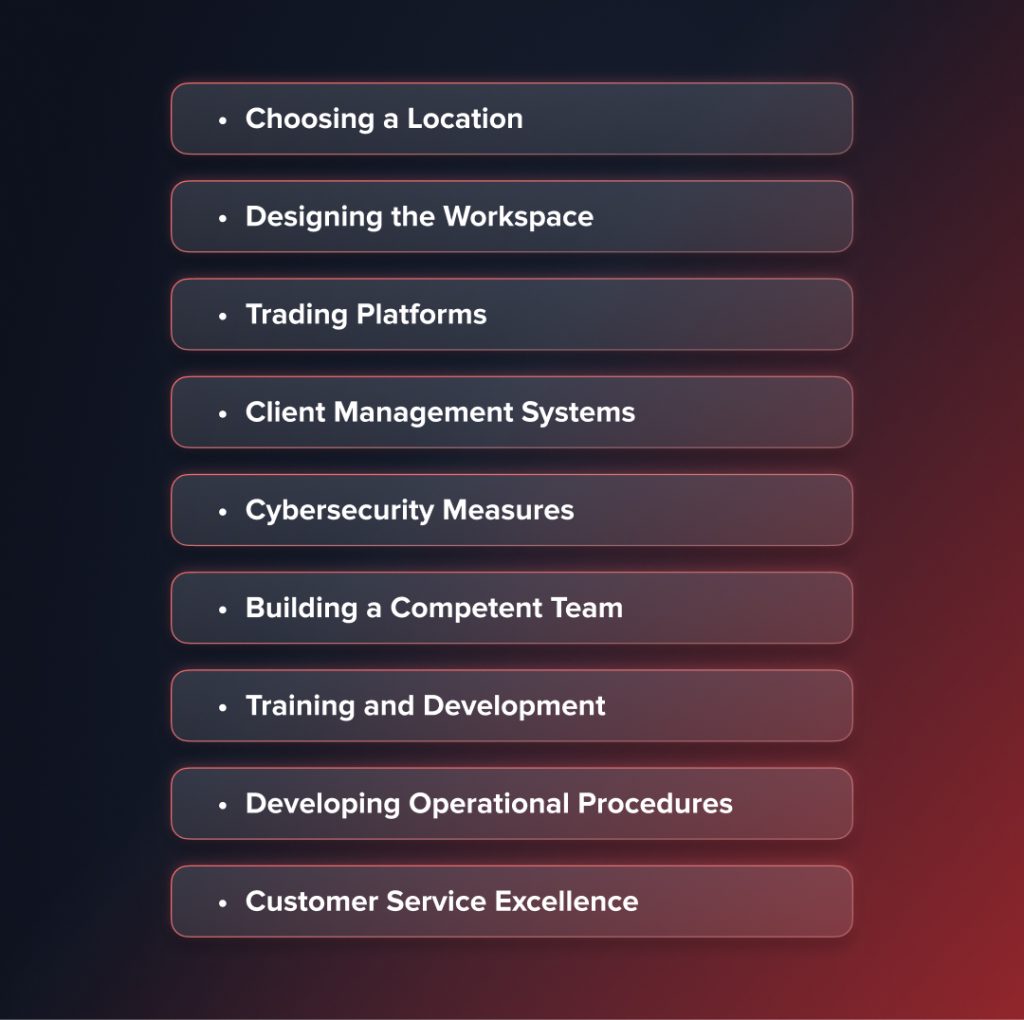
Выбор места
Решите, стоит ли открывать физический офис, работать виртуально или сочетать оба подхода. Для физического офиса учитывайте такие факторы, как доступность для клиентов и сотрудников, близость к финансовым районам и общие затраты. В то же время виртуальные операции предлагают гибкость и сниженные накладные расходы, но требуют надежных технологических решений.
Проектирование рабочего пространства
Если вы выбираете физический офис, создайте рабочее пространство, которое способствует продуктивности и отражает бренд вашего брокера. В нем должна быть необходимая технология и ресурсы для поддержки операций вашей команды.
Торговые платформы
Выбор правильных торговых платформ имеет решающее значение. Эти платформы должны быть надежными, удобными для пользователя и оснащенными современными торговыми инструментами и аналитикой. При выборе платформ учитывайте потребности вашей целевой аудитории.
Системы управления клиентами
Реализуйте системы управления клиентами для эффективного ведения клиентских счетов, транзакций и коммуникаций. Эти системы должны обеспечивать безопасные и бесперебойные операции, начиная с открытия счета и заканчивая исполнением сделок.
Меры кибербезопасности
В современном цифровом мире надежные меры кибербезопасности являются обязательными. Инвестируйте в первоклассную инфраструктуру безопасности, чтобы защитить конфиденциальные данные и средства клиентов от киберугроз.
Создание компетентной команды
Соберите команду квалифицированных специалистов, которые соответствуют ценностям и целям вашего брокерского бизнеса. Это включает в себя найм опытных брокеров, финансовых аналитиков, IT-специалистов и вспомогательного персонала.
Обучение и развитие
Инвестирование в регулярное обучение и развитие имеет решающее значение для того, чтобы ваша команда была в курсе последних рыночных трендов, изменений в законодательстве и технологических достижений.
Разработка операционных процедур
Установите четкие операционные процедуры для всех аспектов вашего брокерского бизнеса, от привлечения клиентов до проверок на соответствие. Это обеспечивает последовательность и эффективность в повседневной работе.
Отличное обслуживание клиентов
Создайте специализированную команду по обслуживанию клиентов или систему для быстрого реагирования на запросы и проблемы клиентов. Отличное обслуживание клиентов имеет решающее значение для удержания клиентов и формирования репутации.
Итог
Операционная инфраструктура вашего брокера — это двигатель, который обеспечивает его успех. Тщательно организуя ваш офис, инвестируя в правильные технологии, создавая квалифицированную команду и оптимизируя операции, вы закладываете основу для брокера, который работает без сбоев, эффективно удовлетворяет потребности клиентов и выделяется на конкурентном финансовом рынке.
Основы технологического стека для брокерских компаний
Технологическая инфраструктура вашего брокера является его основой. Она напрямую влияет на скорость исполнения сделок, клиентский опыт, соблюдение нормативных требований и масштабируемость. Наличие правильных инструментов с самого начала позволяет всему работать более гладко и дает возможность оставаться конкурентоспособным по мере роста.
Ключевая технология, необходимая каждому брокерскому агентству
Торговая платформа
Сердце вашего бизнеса, где осуществляется вся торговая деятельность. Излюбленные брокеры включают MetaTrader 5 (MT5), cTrader или индивидуальную платформу. Ищите такие функции, как быстрая исполнение, охват мульти-активных классов, мобильный доступ и настраиваемые интерфейсы.
Инструменты управления рисками
Необходимы для управления рисками и защиты капитала. Ликвидные мосты, панели мониторинга в реальном времени и автоматические уведомления о рисках позволяют управлять потоком заказов и поддерживать финансовую стабильность.
CRM & Портал клиента
Надежная CRM-система упрощает процесс onboarding, проверку KYC/AML и коммуникацию с клиентами. Интегрированные клиентские порталы повышают прозрачность, позволяя пользователям в режиме реального времени отслеживать сделки, депозиты и результаты.
Решения для обработки платежей
Включите многовалютные платежи, мгновенные депозиты и бесшовные выводы средств. Интеграция с основными платежными шлюзами (например, Stripe, Worldpay) и PSP является ключевой для снижения трения и улучшения пользовательского опыта.
Системы соблюдения норм и AML
Автоматизированное программное обеспечение для соблюдения нормативных требований обрабатывает проверки KYC, мониторинг транзакций, отчеты о подозрительной деятельности и регуляторную отчетность. Это не только гарантирует соблюдение法律, но и создает доверие со стороны регуляторов и клиентов.
Хостинг и инфраструктура
Серверы высокой производительности, решения VPS и системы резервного копирования гарантируют работоспособность платформы и низкую задержку, что критически важно для скорости выполнения и удовлетворенности клиентов.
Приоритизируйте масштабируемость и интеграции. Ваш технологический стек должен быть способен поддерживать новые классы активов, международные клиентские базы и развивающиеся требования регулирования по мере роста вашего брокерского бизнеса.
Шаг 5: Реализация стратегий маркетинга и привлечения клиентов
Разработка и внедрение эффективных стратегий маркетинга и привлечения клиентов для любого нового брокера являются важными шагами на пути к обеспечению роста и установлению надежного присутствия на конкурентном финансовом рынке.
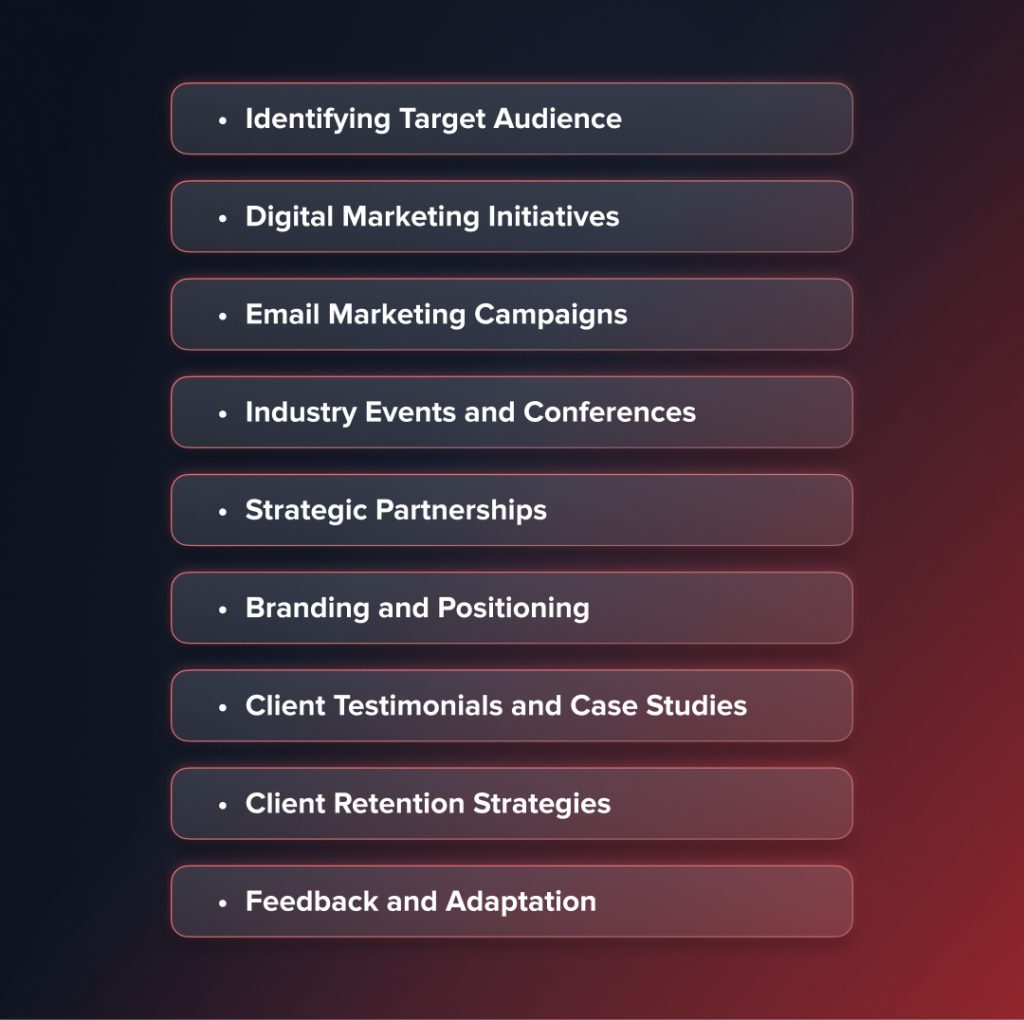
Определение целевой аудитории
Начните с определения вашей целевой аудитории на основе вашей брокерской ниши. Понимание демографических данных, торговых привычек и предпочтений ваших потенциальных клиентов является ключом к эффективному адаптированию ваших маркетинговых усилий.
Инициативы цифрового маркетинга
В современном цифровом мире наличие сильного онлайн-присутствия имеет решающее значение. Это может включать в себя оптимизацию для поисковых систем (SEO) для улучшения вашей видимости в поисковых системах, контентный маркетинг для установления вашей экспертизы и предоставления ценности потенциальным клиентам, а также маркетинг в социальных сетях для взаимодействия с клиентами на платформах, которыми они пользуются.
Кампании по email-маркетингу
Используйте email-маркетинг, чтобы информировать и вовлекать потенциальных и существующих клиентов. Регулярные рассылки, обновления рынка и персонализированные предложения могут эффективно поддерживать постоянное общение и строить отношения.
События и конференции в индустрии
Участвуйте в мероприятиях отрасли, конференциях и вебинарах, чтобы установить контакты с потенциальными клиентами и партнерами. Эти мероприятия предлагают видимость бренда и могут продемонстрировать экспертизу и услуги вашей брокерской компании.
Стратегические партнерства
Сформировав партнерские отношения с финансовыми педагогами, экспертами по торговле или поставщиками дополнительных услуг, вы можете открыть возможности для рефералов клиентов и совместных маркетинговых усилий. Эти партнерства могут расширить ваш охват до новых сегментов клиентов.
Брендинг и позиционирование
Разработайте сильную бренд-идентичность и убедитесь, что ваш брендинг последователен во всех маркетинговых материалах и каналах. Уникально позиционируйте свою брокерскую компанию на рынке, чтобы выделиться среди конкурентов.
Отзывы клиентов и тематические исследования
Используйте отзывы клиентов и примеры успешных кейсов для повышения доверия и авторитета. Поделитесь историями успеха довольных клиентов — это может быть мощным инструментом для привлечения новых клиентов.
Стратегии удержания клиентов
Помимо привлечения новых клиентов, сосредоточьтесь на стратегиях удержания, чтобы создать лояльную клиентскую базу. Это включает в себя предоставление исключительного обслуживания клиентов, предложение персонализированных торговых советов и последовательное предоставление ценности.
Обратная связь и адаптация
Регулярно запрашивайте отзывы у клиентов и адаптируйте свои стратегии соответственно. Оставаясь в курсе потребностей клиентов и изменений на рынке, вы обеспечиваете актуальность и эффективность своих маркетинговых усилий.
Итог
Реализация эффективных маркетинговых стратегий и стратегий привлечения клиентов является динамичным и непрерывным процессом, который требует адаптивности, креативности и глубокого понимания вашей целевой аудитории. Сочетая цифровой маркетинг, нетворкинг, стратегические партнерства и сильный брендинг, ваше агентство может создать значительное присутствие на рынке, привлечь разнообразную клиентскую базу и способствовать долгосрочным отношениям с клиентами, которые необходимы для устойчивого роста.
Шаг 6: Принятие инноваций и технологических достижений
В быстром мире брокерских услуг оставаться на шаг впереди часто означает принятие последних технологических достижений и инновационных практик. Этот шаг имеет решающее значение для повышения операционной эффективности, улучшения клиентского опыта и поддержания конкурентного преимущества на рынке.
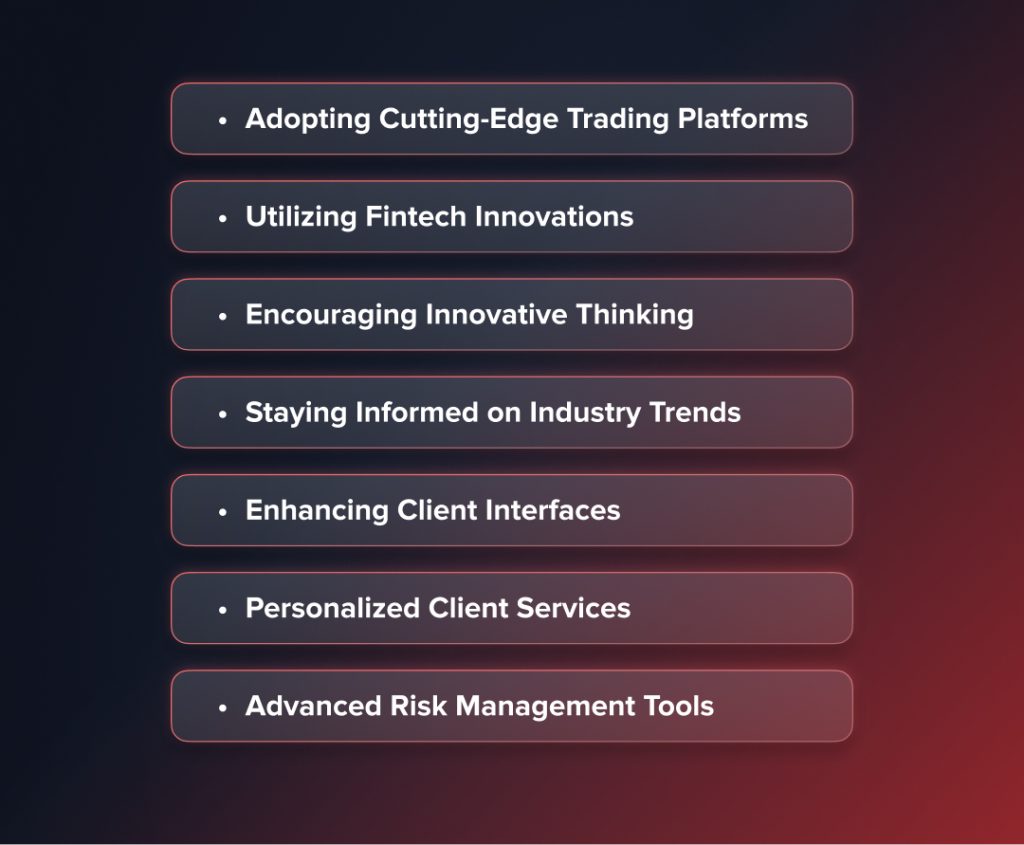
Принятие передовых торговых платформ
Непрерывно оценивайте и интегрируйте современные торговые платформы, которые предлагают превосходную производительность, улучшенную безопасность и лучший пользовательский опыт. Это может включать платформы с аналитикой на основе ИИ, возможностями автоматической торговли и обработкой данных в реальном времени.
Использование финансовых технологий
Изучите инновации в финтехе, такие как блокчейн для безопасных транзакций, робо-консультанты для автоматизированных советов клиентам и анализ больших данных для получения рыночных инсайтов. Эти технологии могут значительно улучшить предложения услуг и операционную эффективность.
Стимулирование инновационного мышления
Создайте рабочую среду, которая поощряет креативность и инновационное мышление. Регулярные сессии мозгового штурма, мастерские по инновациям и стимулы для инновационных идей могут способствовать культуре постоянного улучшения и адаптации.
Оставаясь в курсе тенденций в отрасли
Будьте в курсе последних тенденций и нововведений в финансовом и технологическом секторах. Посещайте отраслевые конференции, подписывайтесь на соответствующие публикации и участвуйте в профессиональных сетях, чтобы собирать новые идеи и инсайты.
Улучшение интерфейсов клиентов
Регулярно обновляйте технологии, ориентированные на клиентов, такие как мобильные приложения, клиентские порталы и инструменты коммуникации, чтобы обеспечить их удобство в использовании, богатый функционал и бесшовный опыт для клиентов.
Персонализированные услуги для клиентов
Реализуйте технологические решения, которые позволяют предоставлять персонализированные услуги клиентам, такие как индивидуальные инвестиционные портфели, настроенные инструменты оценки рисков и интерактивные интерфейсы финансового планирования.
Расширенные инструменты управления рисками
Используйте сложное ПО для управления рисками, чтобы контролировать и смягчать риски, связанные с торговой деятельностью. Это включает в себя инструменты для мониторинга соблюдения требований, анализа рыночных рисков и оценки кредитных рисков.
Оптимизация настройки брокера с помощью решений под собственным брендом
Для предпринимателей, стремящихся войти на рынок Форекс, навигация по сложностям становления брокером может быть непростой задачей. Каждый шаг требует значительных усилий и инвестиций, начиная от определения вашей ниши и обеспечения соблюдения норм до разработки бизнес-плана и операционной инфраструктуры. Однако упрощенный подход облегчает этот процесс: использование решений с белой этикеткой.
Сила решений под частные бренды
Решения под маркой предлагают комплексный пакет, который охватывает основные компоненты, необходимые для запуска и ведения форекс-брокера. Этот подход предоставляет готовую к рынку платформу вместе с необходимыми операционными инструментами и услугами, все настраиваемые под ваш бренд. Вот как решения под маркой упрощают процесс становления форекс-брокером:
- Быстрый выход на рынок: Платформы под собственным брендом заранее разработаны, полностью интегрированы и готовы к развертыванию. Это значительно сокращает время запуска, позволяя новым брокерским компаниям быстро и эффективно выходить на рынок, часто в течение нескольких недель.
- Экономически выгодно: Разработка торговой платформы и инфраструктуры с нуля требует значительных финансовых ресурсов, часто превышающих 100 000 долларов из-за сложностей разработки программного обеспечения, соблюдения нормативных требований и настройки инфраструктуры. В отличие от этого, решения под белую марку представляют собой экономически выгодную альтернативу, с затратами, начинающимися от около 20 000 долларов, что исключает необходимость в крупных первоначальных инвестициях в разработку технологий.
- Настройка и брендинг: Решения с белой этикеткой предлагают обширные возможности кастомизации, несмотря на то что они уже заранее разработаны. Брокеры могут применять свой брендинг и адаптировать внешний вид и функциональность платформы под свои и потребности своих клиентов.
- Соблюдение нормативных требований: Многие поставщики с белыми ярлыками разрабатывают свои платформы с учетом соблюдения нормативных требований, облегчая выполнение строгих финансовых регуляций.
- Техническая поддержка и обслуживание: Поставщики решений под собственной маркой, как правило, предлагают непрерывную техническую поддержку и обслуживание, обеспечивая бесперебойную работу платформы и её актуальность с последними функциями и мерами безопасности.
Выбор уважаемого провайдера белой марки имеет решающее значение. Ищите провайдеров с проверенной репутацией, надежными мерами безопасности и всесторонней поддержкой. Учитывайте масштабируемость решения, чтобы убедиться, что оно может расти вместе с вашим бизнесом. Также оцените варианты настройки и то, насколько хорошо они могут соответствовать вашему видению для вашего брокера.
Заключение
Создание брокерской фирмы является многогранным процессом, требующим усердия, экспертизы и стратегического подхода. Следуя этим шагам и оставаясь приверженными этическим практикам и постоянному совершенствованию, начинающие брокерские компании могут позиционировать себя для успеха в динамичном мире финансов. Кроме того, использование решений с белой этикеткой может предложить упрощенный путь к выходу на рынок, обеспечивая прочную основу, одновременно позволяя сосредоточиться на росте и привлечении клиентов. Этот путь, хотя и сложен, открывает возможности для значительного роста и влияния на финансовые рынки, при этом решения с белой этикеткой служат мощным катализатором на пути к успеху.
FAQ
Это может занять от 6 до 12 месяцев, чтобы начать брокерскую деятельность, в зависимости от вашей юрисдикции, сроков получения регулирующего одобрения и настройки технологий. В юрисдикциях с более строгими требованиями к лицензированию (таких как США или ОАЭ) это может занять более года.
Да. В большинстве юрисдикций незаконно вести бизнес по операциями с Forex или ценными бумагами без лицензии. Условия лицензирования различаются в зависимости от региона, но обычно они включают минимальный капитал, политику соблюдения, процедуры AML/KYC и требования к постоянной отчетности.
Абсолютно. Большинство брокерских компаний начинают без внутренней технической экспертизы, используя платформы под собственным брендом или сотрудничая с поставщиками технологий. Эти решения обрабатывают настройку, торговые платформы и программное обеспечение для бэк-офиса, чтобы вы могли сосредоточиться на соблюдении нормативных требований, брендинге и привлечении клиентов.
Обновлено:
10 октября 2025 г.




